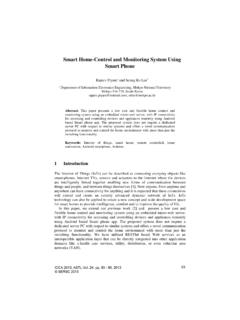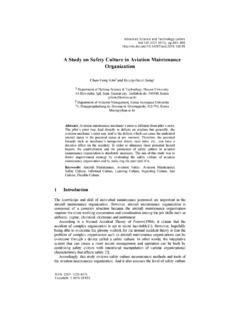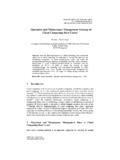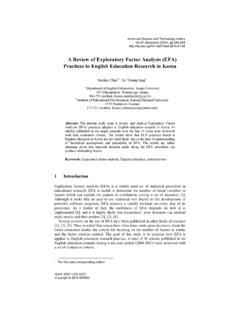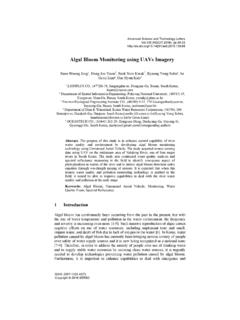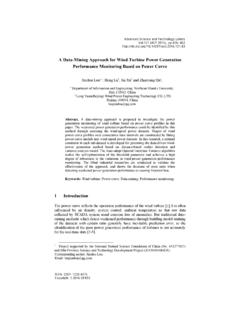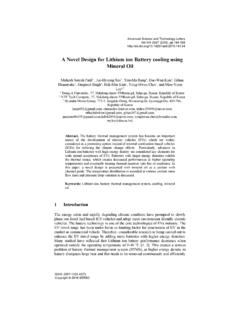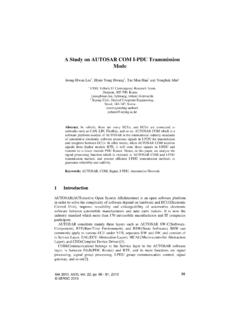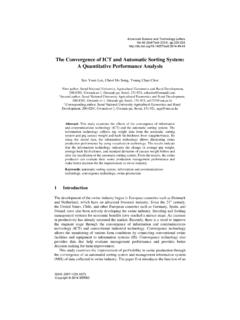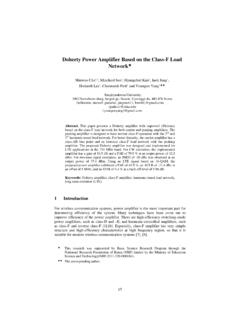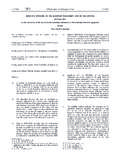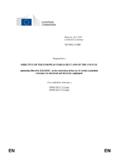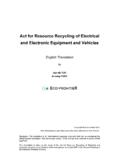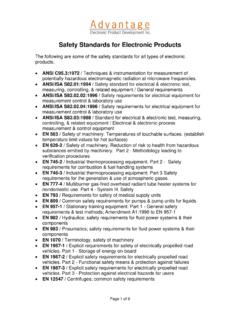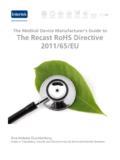Transcription of Material Recycling and Flow of Waste Electrical and ...
1 Material Recycling and Flow of Waste Electrical and electronic equipment in Korea Yong-Chul Jang1* , Seunghun Lee2, Youngjae Ko3 , Kyunghoon Choi4 1*Department of Enviornmental Engineering, Chungnam National Univesity, 99 Dahak-ro, Yuseong-gu, Daejoen 305-764, South Korea. 2 Department of Enviornmental Engineering, Chungnam National Univesity, 99 Dahak-ro, Yuseong-gu, Daejoen 305-764, South Korea. 3 Department of Enviornmental Engineering, Chungnam National Univesity, 99 Dahak-ro, Yuseong-gu, Daejoen 305-764, South Korea. 4 Department of Enviornmental Engineering, Chungnam National Univesity, 99 Dahak-ro, Yuseong-gu, Daejoen 305-764, South Korea. Abstract. The proper management of Waste Electrical and electronic equipment (WEEE) or electronic Waste (e- Waste ) has become a major issue of concern for solid Waste communities due to the large volumes of the Waste being generated as well as the potential resource recovery associated with rare metals found in discarded electronic devices.
2 Improper management of such Waste can cause potential environmental impacts associated with toxic chemicals found in most electronic devices. This paper presents the current management system and Recycling efforts of WEEE in Korea. Specifically, the generation rates, Recycling target rates, and the EPR (extended producer responsibility) system of e- Waste have been discussed. The results indicate that life spans of e- Waste ranged from year for mobile phone to year for refrigerator and washing machine. The results in this study by using the Monte-Carlo simulation method showed that the national Recycling target rate in 2017 was predicted to be kg/person/year on average (5% percentile kg/person/year, 95% percentile kg/person/year).
3 The AHP modeling was also performed to expand the WEEE list by the EPR. Recent WEEE policy efforts (expansion of the EPR list, shared responsibility of distributors with producers, and better collection system by local governments) with diverse collection programs and the development of advanced e- Waste Recycling technology would increase collection and Recycling rates of the Waste . The strengthened WEEE regulations would encourage its producers to develop more environmentally sustainable products, and require them to take extended responsibility for the Recycling of their products. Keywords: Material Recycling , electronic Waste , WEEE. 1 Introduction Waste Electrical and electronic streams encompass a wide range of Electrical and electronic Waste products, including home appliances ( , refrigerators, washing machines, air conditioners); information technology and telecommunication Advanced Science and Technology Letters (Materials 2014), : 2287-1233 ASTL Copyright 2014 SERSC equipment ( , personal computers, laptop computers, printers, copying equipment , calculators, facsimiles, telephones, mobile phones); consumer electronic devices ( , televisions, radios, video cameras, audio equipment ); and other household Electrical and electronic equipment ( , vacuum cleaners, toasters, coffee machines, hair dryers, watches, or irons).
4 The large consumer demands for newer electronic products and the advanced development of information and communication technology (ICT) have resulted in tremendous amounts of Waste Electrical and electronic equipment (WEEE) that are disposed of. The disposition and management of WEEE is an emerging environmental issue of concern for the solid Waste communities in the world [1, 2, 3, 4, 5, 7]. As the life spans of electronic devices are becoming shorter, the quantity of WEEE is expected to increase in the future. This study presents an overview of the current management system of e- Waste in Korea. The generation rates of e- Waste in Korea were estimated. 2 Methodology The methodology of this study included gathering the data associated with annual domestic demands of 10 different home appliances and electronic devices, site visits, questionnaire surveys, interviews and conversation, and a review of available literature.
5 3 Results and Discussion Generation Rate of WEEE The estimated amount of WEEE generated can be determined by the retired amount of WEEE subtracted the volume of WEEE that is reused, loaned, or stored at households. Based on the assumptions above, the retired and generated rate of WEEE in Korea in 2012 can be estimated, as shown in Figure 1. Fig. 1. Retired and generation rate of WEEE in Korea (2012) Advanced Science and Technology Letters (Materials 2014)10 Copyright 2014 Recycling Processes of WEEE Recycling processes to recover valuable materials ( , ferrous metal, copper, and aluminum) from WEEE at electronic Waste Recycling facilities in Korea typically include manual dismantling, size reduction, magnetic separation, eddy current separation, density separation, and cyclone separation.
6 In the practice of Recycling WEEE, as a first step, it is very common to manually dismantle obsolete consumer devices to recover highly valuable materials and to remove potentially toxic materials ( , such as CFCs, PCBs). Since composition of WEEE is diverse and complex in terms of components and materials, it is very important to identify both valuable materials and toxic substances [6]. There are also potential health hazards from fumes, dusts, and harmful chemicals affecting the Recycling workers who process the components. Data regarding the emission of air pollutants at WEEE Recycling facilities in Korea is very limited so far. Predicted Recycling Target Rates of WEEE The Recycling rates are expected to continually increase over the coming years.
7 In 2017, the rate can reach up to kg/person/year, based on the simulation performed by this study. Figure 2 presents the target Recycling rate of WEEE by category. The largest contribution category was found to be large home appliances such as refrigerators, washing machines, air-conditioners, and Electrical oven, followed by audio and video equipment ( , TVs, audio equipment ). Fig. 2. Predicted target Recycling rate of WEEE category using Monte-Carlo simulation method Material Flow of WEEE in Informal Sectors Based on the results of this study, it is estimated that in 2011 approximately 62,265 tons of used TVs from households were collected by private collectors and sent to Advanced Science and Technology Letters ( Material 2014)Copyright 2014 SERSC11private collection points (or junk shops) (Fig.)
8 3). Private local recyclers and dealers accept large fractions of the collected TVs, and then export them to overseas for Recycling and reuse. Negative environmental impacts that arise from the movement of used electronics in developing countries have become an issue of concern in international solid Waste community. Fig. 3. Material flow of TVs in informal sector in 2011 4 Conclusion Waste Electrical and electronic equipment (WEEE) is one of the fastest growing solid Waste streams. The current management policy and regulation of WEEE in Korea have focused on large home appliances and limited IT products ( , computers, printers, or mobile phones). The national Recycling target rate was predicted to be kg/person/year on average (5% percentile kg/person/year, 95% percentile kg/person/year).
9 The results in this study showed that approximately 133,000 tons of WEEE were recycled by Material recovery in 2012 with the largest volume of refrigerators. In response to the increasing volumes of WEEE and their potential environmental impacts through various disposal pathways, Electrical and electronic products in the Recycling list by the EPR need to be expanded, including small home appliances ( , vacuum cleaners, rice cookers, electric fan, microwave) and other IT products ( , MP3 players, scanners, DVD players). Recent WEEE policy efforts (expansion of the EPR list, shared responsibility of distributors with producers, and better collection system by local governments), along with better Recycling technology, would increase collection and Recycling target rates of WEEE through diverse collection programs, encourage its producers to develop more environmentally sustainable products, and require producers to take extended responsibility for the Recycling of their products.
10 Advanced Science and Technology Letters (Materials 2014)12 Copyright 2014 SERSCR eferences 1. Babu, B., Parande, A., Basha, C.: Electrical and electronic Waste : a Global Environmental Problem. Waste Manage. 25, 307-318 (2007) 2. He, W., Li, G., Ma, X., Wang, H., Huang, J., Xu, M., Huang, C.: WEEE Recovery Strategies and the WEEE Treatment Status in China. J Haz Mat. B136, 501-512 (2006) 3. Kahhat, R., Kim, J., Xu, M., Allenby, B., Williams, E., Zhang, P.: Exploring E- Waste Management Systems in the United States. Res Conser Recy 53, 955-64 (2008) 4. Ongondo, F., Williams, I., Cherrett, T.: How are WEEE doing? A global review of the management of Electrical and electronic wastes, Waste Manage. 31, 714-730 (2011) 5. Robinson, B.: E- Waste : An Assessment of Global Production and Envrionmental Impacts, Sci Tot Environ.
